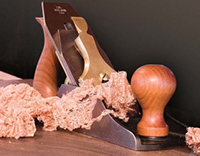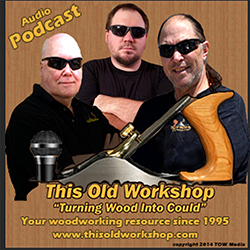Lie-Nielsen No. 4 ½ Smoothing Plane
Lie-Nielsen No. 4 ½ Smoothing Plane

When Joseph Moxon shunned the smoothing planer he gave the nod to the fore plane, or what we today call the jackplane. The Jack is a real workhorse, especially if you set it up to be used as it was intended. Most woodworkers don’t know how to set the jack up correctly but a recent Woodwright’s Shop episode featuring Christopher Schwartz went into some of Moxon’s written theory describing how to set up the Jackplane and this video is well worth the watch.
You can find it here http://video.pbs.org/video/2172600556/
Correctly, Roy demonstrates in great comical form how we all have an obsession with our smoothing planes, whether a No. 1, 2, 3, 4, or 4 ½ the smoother is the most fun to use of all the bench planes. There is nothing like the gossamer shavings of a well-tuned smoothing plane and while you can get good performance from an old classic like a Stanley or a Clifton or a Keen Kutter, you can put yourself into a different league if you step up and buy a premium hand plane like a modern Veritas or Lie-Nielsen. Or even the new Sweetheart Stanley.
Like so many users I find myself drawn to certain brands of tools and I have always liked the Stanley flat top Bedrock planes the best. Now some of these classic Stanley’s can go for several hundred dollars. My 602 is worth close to a grand because it’s flawless, however in the past 10 years or so I have purchased several Lie-Nielsen hand planes. The one I like best is one that you can’t go out and buy today. It’s a bronze Lie-Nielsen 4 ½ with all three frogs and a couple extra irons, including a toothed iron. As an assembled package this lovely plane and associated pieces ran close to a grand but it is my go to plane. I also purchased a ductile iron No. 4 ½ from Lie-Nielsen including an additional 50 degree frog for it.
There is a huge weight difference in the two planes but for this review we will be looking at the ductile iron model at 5 ½ pounds, 10 ¾ inches long and 2 ½ inches wide. The No. 4 ½ plane is a great option for most serious woodworkers at a base price of $325.00. This Bedrock style plane is IMHO the finest smoothing plane available today. What makes this modern version so nice? Well let’s start with the stress relieved casting of ductile iron. Lie Nielsen was the first manufacture to use ductile Iron in their hand planes and they did it for a good reason. The ductile iron is not fragile like cast iron so god forbid, if you were to drop your plane from your bench top you would not be out hundreds of dollars making the owner a much happier camper. Should a drop occur to a classic plane you’re done. All you will have left will be a few cracked or broken parts. Stress relieving is an essential part to making the plane stay flat after it is machined. So after casting, the casting is placed in an oil bath and kept warm for a few days then slowly cooled. After that it’s machined flat to the highest standard in the business. Unlike many other planes, you do not have to flatten the sole of a Lie-Nielsen bench plane. They are ready to be honed and used right out of the box. This is something Tom Lie Nielsen strived for from day one and it is also something he achieved and maintained from that day. Next is the marvelous totes and knobs used on these planes. They come in two woods, cherry and cocobolo. They each have such an appeal I like them both equally and they are now a satin finish. Early Lie-Nielsens had an extreme high gloss finish that looked even better but they are not allowed to use that finish any longer. I think they are almost as nice as the East Indian Rosewood totes of the past that we can no longer get because of the Cities Treaty.
Using the No. 4 1/2 is a pure joy. I sharpened it using the Naniwa stones ending in a 12,000 grit. The blades are A-2 steel and hold their edge for a long time. I also used the Charlsworth ruler trick to do the back of the blade, it’s far quicker than obsessing over a mirrored back on the iron and it cuts at least as well as a blade with a mirror back. I like the 3 frogs too, it is easy to change them out to get the best results depending on the species and figure of the wood you’re finishing. . It is easy to get full thickness shavings from this plane and I love the results I get. Most of the time I use the 50 degree frog as it gives me less tear out but is easier to push than the 55 degree frog. Making adjustments to the Bedrock designed planes is unbeatable, you simply loosen the two frog retaining screws and then turn the frog adjustment screw until you have the mouth as tight as you dare. A few years back Lie-Nielsen changed their chip breaker to a thicker model and they offer the improved version as a replacement. If you own an older L-N bench plane that has the old chip breaker on it you can buy the improved version which makes a huge difference in performance. If you make the upgrade you won’t regret it. All in all, this is one of the best hand planes you can get without waiting two years for a one of a kind, or a Bridge City model that is 5 times the price. I give this plane 5 out of 5 stars on my star scale and I am sure my grandchildren will fight over these planes when I am gone as they are truly heirloom tools. The Lie-Nielsen No. 4 ½ is my go to smoother for all my case work projects and I truly love them. That’s why I own 2 of them.
Lance Granum


















